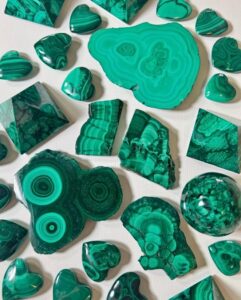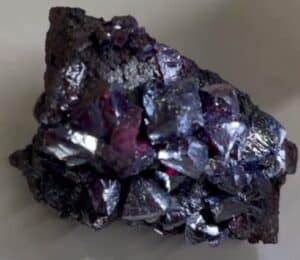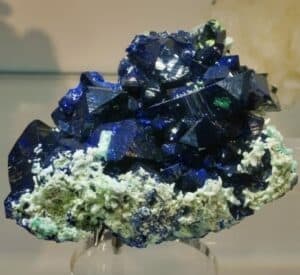Copper minerals are broadly classified into Oxide minerals, Sulfide minerals, and Native Copper. The most common Copper mineral is Chalcopyrite which is a Sulfide mineral. The interesting part about Copper minerals is the wide range of geological settings they can occur in, including Porphyry Copper deposits, Sedimentary Copper deposits, and skarns.
Now you have a basic understanding of Copper minerals we can jump into all of the types of Copper minerals you can collect.

List of Copper Ores
I’ve put together a list of my favorite Copper Ores or minerals, depending on how you look at it, to collect. By no means, does this list cover every Copper mineral but the ones listed below are the coolest specimens you can collect.

Chalcopyrite: This is the most common of the Copper minerals, containing about 34% Copper by weight. It’s a Sulfide mineral that generally occurs in large deposits. It is the primary source of Copper production worldwide. You’ll be able to source these at your local rock and mineral show and they don’t cost too much. Focus on good crystal structure, clean matrix, and an over all great appearance.

Bornite: This is also known as Peacock Ore because of its beautiful array of colors. It’s also a Sulfide mineral and contains up to 63% Copper by weight. It’s often found in association with Chalcopyrite, making it a secondary source of Copper production. These can be found everywhere and they look really cool but they don’t retain a ton of value. If you’re a junior rockhound then these are great for a starter collection.

Chalcocite: This secondary copper mineral forms from the weathering of primary Sulfide minerals, like Chalcopyrite. It contains up to 80% copper by weight, and it’s an essential source of Copper in some deposits. Chalcocite is pretty cool, look at the image above. The crystal structure is stacked on top of each other with an iridescence coating.

Malachite: Malachite is a Copper carbonate mineral that forms from the weathering of primary Copper minerals. It contains around 57% Copper by weight, and it is an essential secondary source of Copper production. Unless you’ve been under a rock, then you’ve heard of or bought a piece of Malachite by now. My favorite pieces are the bullseye’s with tight banding and contrasting green colors.

Cuprite: A Copper oxide mineral containing up to 88% Copper by weight. It’s often found in association with other Copper minerals, including Chalcocite and Native Copper. It’s a minor source of Copper production. Cuprite can be difficult to source but there are specimen dealers with inventory. This is another favorite mineral of mine because the outside has a metallic look but when you shine a light through it, a gorgeous red color appears.

Native Copper: Here, we have Copper in its pure metallic form, and it’s a rare mineral. It’s often found in association with other Copper minerals and serves as a minor source of Copper production. If you want to own one of these amazing Copper and Quartz matrix cabochons then you can buy them from Gary B Wilson.

Azurite: This Copper carbonate mineral is often found in association with Malachite. It contains up to 55% Copper by weight and serves as a secondary source of Copper production. Azurite crystals are my favorite type to collect because of their rarity and overall appearance.

Covellite: A Sulfide mineral containing up to 66% Copper by weight. It is often found in association with Chalcocite and serves as a secondary source of Copper production. Not much to look at here and kind of boring.

Enargite: This Sulfide mineral contains up to 48% Copper by weight and is often found in Porphyry Copper deposits. It is a secondary source of Copper production. These are pretty cool-looking specimens but can be difficult to source. You’ll have to wait until a deposit is found and then buy the best specimens from the deposit.

Tetrahedrite: A Sulfide mineral containing up to 30% Copper by weight, as well as other metals, including Zinc, Silver, and Antimony. It’s often found in association with other Copper minerals, serving as a secondary source of Copper production.

Digenite: A Sulfide mineral containing up to 79% Copper by weight. It’s often found in association with Chalcocite and serves as a secondary source of Copper production.

Tenorite: A Copper Oxide mineral containing up to 79% copper by weight. It can be found in association with other Copper minerals and serves as a minor source of Copper production.
Where Is Copper Found?
Copper is found in numerous regions of the world. It typically comes from Copper Ore, but small amounts of Native Copper can be found in distorted cubic crystal specimens. Keweenaw Peninsula, near Lake Superior in Michigan, is one of the most likely areas to find Native Copper.
The United States is the second largest producer of Copper on the planet. The largest Copper mine in the US is found in Utah (Bingham Canyon) but there are other significant mines in Arizona, New Mexico, Montana, and Michigan. In South America, Chili (the world’s largest producer) and Peru are both major Copper producers. Large copper deposits can be found in Canada, the Ural Mountains of Russia, and various parts of Africa.
Hardness of Copper
Copper is fairly soft and registers a 3.5 on Moh’s Hardness Scale.
How Is Copper Formed?
Copper is a metal that’s been deposited from hot sulfur solutions that are created in volcanic regions. The host sulfur solutions concentrate the copper up to 1,000 times more than we’d typically find in rocks. The result is enriched rocks called Copper Ore.
History of Copper
It’s believed that Copper was the first metal used by humans and it was first discovered by Neolithic Beings about 9,000 years ago. Humans figured out how to use it in place of stone because it was much easier to shape.
Early coppersmiths in Iran found that heating Copper softens it and hammering it makes it harder. This allowed them to shape Copper into various useful items like utensils and containers. As civilization progressed, humans started using it for jewelry and ornaments.
There’s evidence that Copper was used from early times, with a piece of Copper tubing being unearthed by archaeologists from a Pyramid in Cheops in Egypt. That tubing dates back 5,000 years.
Needless to say, Copper has been utilized and had a purpose as far back as ancient times. It was used in similar ways as we use it today. Copper’s applications are many in this modern world, which shouldn’t be surprising since its uses reach back to the BC era. Maybe Neolithic peoples were more up-to-date than we imagined.
- Identify Enstatite - March 12, 2024
- Identify Cerussite - March 3, 2024
- Identify Bytownite - February 18, 2024
